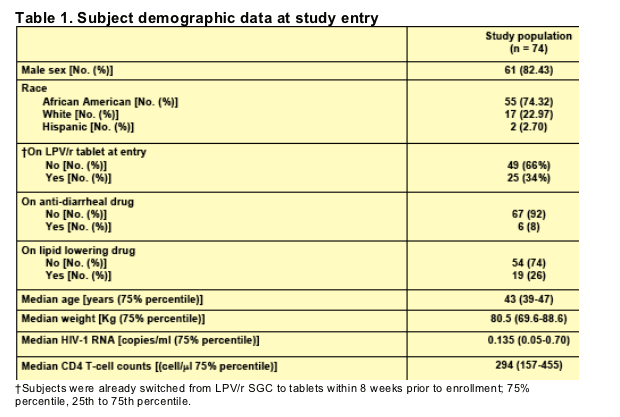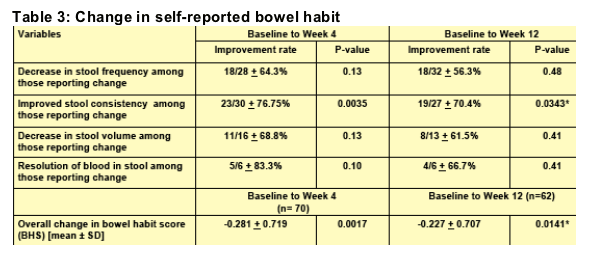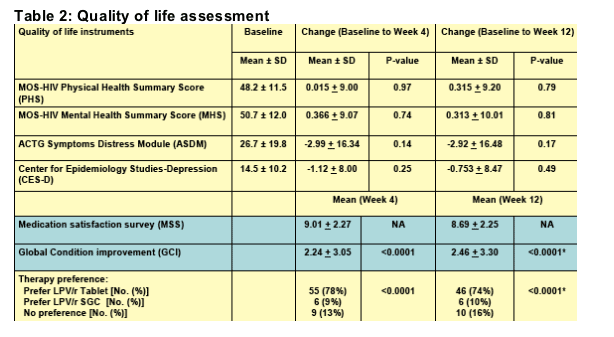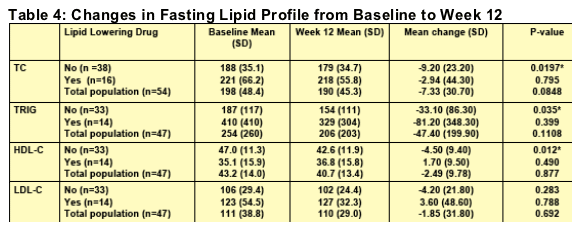 |
 |
 |
| |
Switching from Lopinavir/Ritonavir (LPV/r) Soft Gel Capsule (SGC) to Tablet Formulation improves Tolerability in Indigent AIDS Clinic
|
| |
| |
Reported by Jules Levin
IDSA, Oct 5, 2007
San Diego, CA
1Ighovwerha Ofotokun, MD, MSc., 2Susan K. Chuck, Pharm.D., 1Maria Rivas, M.D., 2Richard Rode, PhD, 2Kelly O'Neil, Pharm.D.
1Emory University, Atlanta, GA, USA; 2Abbott Laboratories, Abbott Park, IL.
Contact: Emory University, ID Division, 69 Jesse Hill Jr. Drive. Atlanta, GA, 30303, USA; iofotok@emory.edu
ABSTRACT
Background: LPV/r tablets compared to SGC have no oleic acid or sorbitol, have no refrigeration/food requirements, and have less pharmacokinetic variability. It was our objective to evaluate tolerability, quality of life (QoL), and lipid differences after switching from LPV/r SGC to Tablet.
Methods: Seventy-four HIV-infected subjects on LPV/r-based regimens were enrolled prior to (25/74) or within 8 wks (49/74) after switching from LPV/r SGC to Tablet. Formulation preference and satisfaction were assessed post-switch. Tolerability assessments included bowel habit (BH), global condition improvement (GCI), and ACTG symptom distress module (ASDM). Tolerability, QoL, and fasting lipids pre-switch were compared to Wk4 and Wk12. Baseline QoL and BH were recalled for those subjects enrolled post-switch.
Results:
At Wk4, more patients preferred LPV/r Tablet to SGC (74% vs. 8%) and satisfaction with the Tablet formulation was expressed.
Significant improvement in BH was reported at Wk4 (mean change in BH-score:
-0.281, p=0.002) and maintained through Wk12 (p=0.014).
Overall LPV/r tolerability improved with the switch.
At Wk4, 45% of subjects felt "better", 45% felt "about the same", 5% "worse", and 5% did not respond.
These GCI-improvements were maintained through Wk12 (p<0.0001).
Correlation was seen between the BH-score and GCI-improvement at Wk4
(p=0.017) and waned by Wk12.
ASDM and QoL were unchanged at Wk4 and Wk12.
Interestingly, a mean reduction in triglycerides of 33mg/dl (18%), unrelated
to lipid-lowering therapy, was observed at Wk12 (n=33, p=0.035).
Conclusions: Switching from LPV/r SGC to Tablet resulted in significant improvement in gastrointestinal tolerability with a resulting positive impact on subjects' overall well being (GCI). QoL was maintained. The observed 18% reduction in triglyceride level deserves further evaluation.
BACKGROUND
The new LPV/r 200/50 mg tablet formulation has been well received by clinicians and patients because of its reduced daily pill burden from six SGC to four tablets,
lack of special food requirements needed to achieve desired plasma drug exposure, and its stability at room temperature, eliminating the need for refrigeration [1-2].
Because the new tablet formulation lacks oleic acid [3], an excipient believed to contribute to gastrointestinal (GI) intolerance with the SGC, it has been speculated that the tolerability of LPV/r would improve with the use of the tablet form.
In this study, a phase IV tolerability assessment was conducted in HIV-infected subjects who were switched from the SGC to the tablet formulation of LPV/r. Self-reported daily bowel habit, quality of life (QOL), and fasting lipid profile obtained prior to the switch were compared to similar data obtained 12-weeks post-formulation change.
METHODS
This was a prospective cohort study that enrolled clinically stable HIV-infected subjects receiving LPV/r-based antiretroviral (ARV) regimen.
Screening
-- HIV-subjects age >18 years
-- Enrolled prior to, or within 8 weeks of formulation switch
-- No CD4 cell count restriction
-- No pregnancy/breastfeeding
Daily bowel movement habit was evaluated prior to switch and at weeks 4 & 12 using an instrument that assessed:
- Frequency
- Consistency
- Volume
- Presence of blood in stool
Intervention
QOL instruments were administered prior to switch and weeks 4 & 12:
- MOS HIV health survey
- Global condition improvement questionnaire
- Medication satisfaction survey
- Therapy preference survey
- ACTG Symptom Distress Module (ASDM) -
supplemented with two questions to assess symptoms related to nephrolithiasis
Clinical labs monitored at baseline and at week 12:
- Fasting Lipid Profile
- HIV-RNA PCR
- CD4 T-cell counts
RESULTS


Self-reported bowel habit score (BHS) was assessed on a scale in which stool consistency was (solid =1, loose =3, watery=5); volume (small =1, moderate=3, large=5), blood (no=1, yes=5); Frequency (1 - 5). For example, a subject with baseline responses of: Solid, Moderate, no blood, and frequency of "2" would have a score of: (1 + 3 + 1 + 2)/4 = 1.75 for their baseline summary score. Therefore the scale has a minimum of 1 (best BHS outcome) and a maximum of 5 (worst BHS outcome); SD, standard deviation.


DISCUSSION & CONCLUSIONS
At Week 4, more patients preferred LPV/r Tablet to SGC (74% vs. 8%) and satisfaction with the Tablet formulation was expressed. Significant improvement in bowel habit was reported at Week 4 (mean change in BH-score: -0.281, p=0.002) and maintained through Week 12 (p=0.014).
Switching from LPV/r SGC to Tablet resulted in significant improvement in GI tolerability with a resulting positive impact on subjects' overall well being (GCI). Overall LPV/r tolerability improved with the switch. At Week 4, 45% of subjects felt "better", 45% felt "about the same", 5% "worse", and 5% did not respond. QoL was maintained (as measured by GCI-improvements) through Week 12 (p<0.0001). Correlation was seen between the BH-score and GCI-improvement at Week 4 (p=0.017) and waned by Week 12.
There was not enough evidence to conclude a change in QOL due to the switch in drug formulation as measured by MOS-HIV PHS, MOSHIV MHS, or ASDM scores (Table 2).
Interestingly, a mean reduction in triglycerides of 33 mg/dL (18%), unrelated to lipid-lowering therapy, was observed at Week 12 (n=33, p=0.035). This reduction in triglyceride level deserves further evaluation.
References
1. Collier AC, Ribaudo H, Mukherjee AL, et al. A randomized study of serial telephone call support to increase adherence and thereby improve virologic outcome in persons initiating antiretroviral therapy. J Infect Dis. 2005 Oct 15;192:1398-406.
2. Guest JL, Ruffin C, Tschampa JM, Desilva KE, Rimland D. Differences in rates of diarrhea in patients with human immunodeficiency virus receiving lopinavir-ritonavir or nelfinavir. Pharmacotherapy. 2004 Jun;24(6):727-35.
3. Awni W,Y-L Chiu,T Zhu, et al. Significantly reduced food effect and pharmacokinetic variability with a novel lopinavir/ritonavir tablet formulation. Abstract WeOa0206. 3rd International AIDS Society Conference on HIV Pathogenesis and Treatment. July 24-27, 2005. Rio de Janeiro, Brazil.
4. Wu A. MOS-HIV health survey scoring guidelines. Version 2.97.
This work was supported by resources from the following:
• An independent research grant from Abbott Laboratories
• Emory University CFAR, Clinical and Statistical cores (NIH P30 AI050409)
|
| |
|
 |
 |
|
|